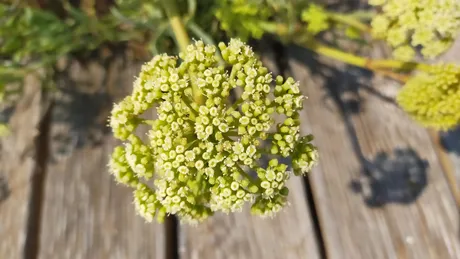
In the cover photo there is the Sea Fennel which is an eatable plant that grows near the sea, along the coasts.
I did not know this plant before my summer vacation in Santa Maria di Leuca (Puglia - Italy), a vacation that unfortunately ended just today. I have to thank my dear mother-in-law Rita because she showed me and taught me how to recognize this plant and especially because she made me eat her tasty salad that has among its ingredients the leaves of the sea fennel (following image).

Sea fennel is a food I really like because in addition to being particularly aromatic it has a salty and slightly spicy note.
Crithmum maritimum
The scientific name of this plant is Crithmum maritimum, it belongs to the family of Apiaceae. I discovered the scientific name thanks to an application I downloaded on my smartphone called PlantNet that allowed me to find out the name of the plant through a simple photograph.
Searching on internet I discovered that the most popular name used for this plant in Italy is "finocchietto marino" or "finocchio marino" but it is also called in many other ways such as "paccasassi", "spaccasassi", "cretamo",...
Sea fennel is a spontaneous and perennial plant, it is very aromatic and grows in places with a lot of humidity.

The Benefits of Sea Fennel
Sea fennel is rich in vitamin C and calcium and also has many beneficial effects because, for example, it facilitates digestion and aids diuresis.
The plant is known for its therapeutic properties; it is used as a vermifuge and to improve liver function[1]. In the past it was used as a valuable source of vitamin C, especially among sailors[2]. The leaves are also rich in carotenoids and flavonoids[3][4] and have stomachic, digestive and choleretic action, stimulating gastric and biliary secretion, promote digestive processes and increase appetite in subjects lacking appetite[5].
English translation from the following source: https://it.wikipedia.org/wiki/Crithmum_maritimum
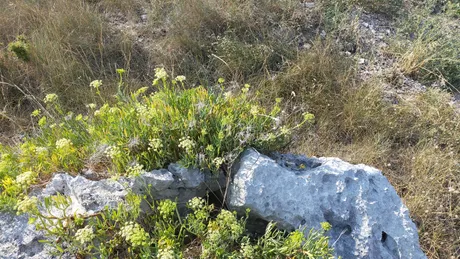
The salad with sea fennel, potatoes, red beets and capers of my mother-in-law Rita
The seeds and leaves of the sea fennel are mainly used in the kitchen and there are many recipes that have this particular food among their ingredients. My dear mother-in-law Rita uses sea fennel to prepare her tasty salad and in the preparation she follows the following procedure:
- She collects the most tender sprigs and leaves from the sea fennel plant and after cleaning them well, she boils them in water and vinegar.
- Boil potatoes in water.
- Boil red beets in water.
- Remove the skin from the potatoes and beets and cut them into slices.
- When the potatoes, sea fennel and beets have cooled, put the three ingredients together in a salad bowl.
- Adds capers
- Adds extra virgin olive oil.
Note: My mother-in-law does not add salt to the salad because both the capers and the sea fennel add flavor to the salad.
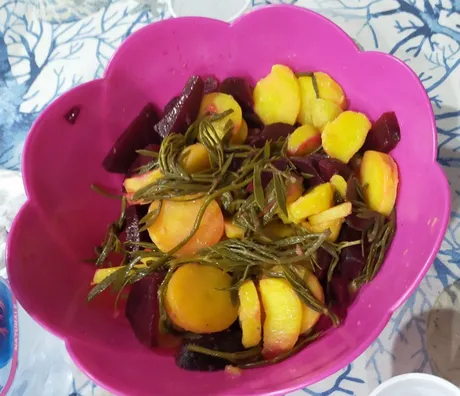
I recommend you try this salad as it is one of my favorite recipes and in the summer, when the temperatures are very high, it can be kept in the fridge and served cold and eating it will be even more enjoyable. The reason why I like this salad so much is the pleasant contrast that is created between the flavors of the various ingredients used:
- the sweetish flavor of the red beet
- the more neutral flavor of the potato
- the salty note of the capers
- the salty and spicy note of the sea fennel.
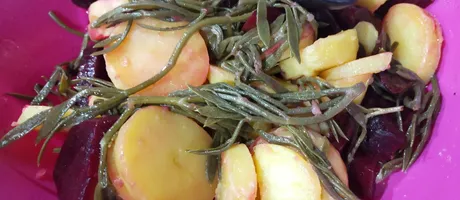
In addition, the nutritional properties of the various ingredients make this salad rich in beneficial effects for the health of the body:
- Potatoes: Potassium, Magnesium, Vitamin C,.
- Red Beets: Fiber, Potassium, Vitamin B9, Vitamin C,...
- Capers: Calcium, Magnesium, Phosphorus, Potassium,...
- Sea Fennel: Calcium, Vitamin C,...
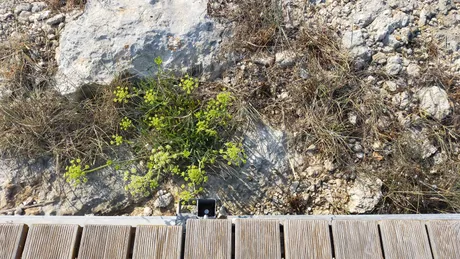
If you are in a seaside location, look around and if you find a sea fennel plant you can try adding the leaves among the ingredients of your salad and trust me, you won't regret it. Remember though, nature gives us so much and for this reason it must always be respected, take the leaves or seeds you need without ever uprooting the plant! ;)


Finocchietto marino: una piacevole e gustosa scoperta! (Crithmum maritimum)

Non conoscevo questa pianta prima della mia vacanza estiva a Santa Maria di Leuca (Puglia - Italia), vacanza che purtroppo è terminata proprio oggi. Devo ringraziare la mia cara suocera Rita perchè mi ha mostrato e mi ha insegnato a riconoscere questa pianta e soprattutto perchè mi ha fatto assaggiare la sua gustosa insalata che ha tra gli ingredienti proprio le foglie del Finocchietto marino (immagine seguente).

E' un alimento che mi piace molto perchè oltre ad essere particolarmente aromatico ha una nota salata e lievemente piccante.
Crithmum maritimum
Il nome scentifico di questa pianta è Crithmum maritimum, appartiene alla famiglia delle Apiacee. Ho scoperto il nome scentifico grazie ad un'applicazione che ho scaricato sul mio smartphone che si chiama PlantNet che permette tramite foto di scoprire il nome della pianta fotografata.
Cercando su internet ho scoperto che il nome popolare più usato per questa pianta in Italia è finocchietto marino o finocchio marino ma è chiamata anche in molti altri modi come ad esempio paccasassi, spaccasassi, cretamo...
Il finocchietto marino è una pianta spontanea e perenne, è molto aromatica e cresce nei luoghi con molta umidità.

I benefici del finocchietto marino
Il finocchietto marino è ricco di vitamina C e calcio e ha anche molti effetti benefici perchè, ad esempio, favorisce la digestione e favorisce la diuresi.
Alla pianta sono riconosciute proprietà terapeutiche; viene usato come vermifugo e per migliorare la funzionalità del fegato[1]. In passato veniva utilizzata come preziosa fonte di vitamina C, specie tra i naviganti[2]. Le foglie sono ricche anche di carotenoidi e flavonoidi[3][4] ed hanno azione stomachica, digestiva e coleretica, stimolando la secrezione gastrica e biliare, favoriscono i processi digestivi e aumentano l'appetito in soggetti inappetenti[5].
Fonte: https://it.wikipedia.org/wiki/Crithmum_maritimum

In cucina si utilizzano principalmente i semi e le foglie del finocchio marino e ci sono molte ricette che hanno tra gli ingredienti questo particolare alimento. La mia cara suocera Rita utilizza il finocchio marino per preparare la sua gustosa insalata e nella preparazione segue il seguente procedimento:
- raccoglie i rametti e le foglie più tenere dalla pianta del finocchietto marino e dopo averli puliti per bene li mette a bollire in acqua e aceto.
- Lessa le patate in acqua.
- Lessa le barbabietole rosse in acqua.
- Toglie la buccia dalle patate e dalle barbabietole e le taglia a fettine.
- Quando le patate, il finocchietto marino e le barbabietole si sono raffreddate mette insieme i tre ingredienti in una insalatiera
- Aggiunge i capperi
- Aggiunge olio extra vergine di oliva.
Nota: Mia suocera non aggiunge sale all'insalata perchè sia i capperi che il finocchietto marino conferiscono sapidità all'insalata.

Vi consiglio di provare questa insalata che è una delle mie ricette preferite e d'estate, quando le temperature sono molto alte, può essere tenuta in frigo ed essere servita fredda e mangiarla sarà ancora più piacevole. Il motivo per cui mi piace tanto questa insalata è il piacevole contrasto che si viene a creare tra i sapori dei vari ingredienti utilizzati:
- il sapore dolciastro della barbabietola rossa
- il sapore più neutro della patata
- la nota salata dei capperi
- la nota salata e piccante del finocchietto marino.

Inoltre le proprietà nutrizionali dei vari ingredienti rendono questa insalata ricca di effetti benefici per l'organismo:
- Patate: Potassio, Magnesio, Vitamina C,...
- Barbabietole Rosse: Fibre, Potassio, Vitamina B9, Vitamina C,...
- Capperi: Calcio, Magnesio, Fosforo, Potassio,...
- Finocchietto marino: Calcio, Vitamina C,...

Se ti trovi in una località di mare, guardati intorno e se trovi una pianta di finocchio marino puoi provare ad aggiungere le foglie tra gli ingredienti della tua insalata e fidati, non te ne pentirai. Mi raccomando però, la natura ci dà tanto e per questo motivo deve essere sempre rispettata, prendi le foglie o i semi che ti servono senza mai sradicare la pianta! ;)
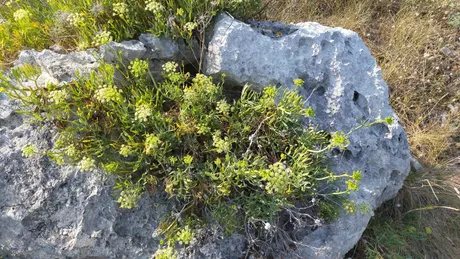

Return from Sea fennel: a pleasant and tasty discovery! (Crithmum maritimum) / Finocchietto marino: una piacevole e gustosa scoperta! (Crithmum maritimum) (ENG/ITA) to libertycrypto27's Web3 Blog

